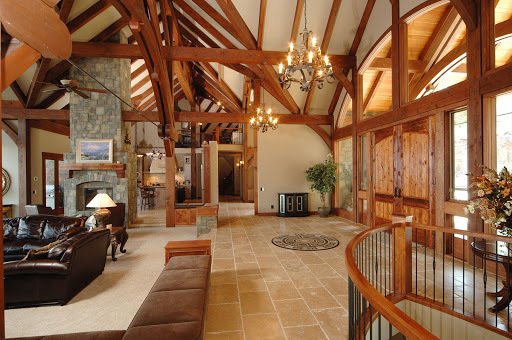Windermere Living Fall Issue

Dear Readers,
Welcome to the fall issue of Windermere Living! Are you a foodie who loves to travel? Inside this issue is an article about interesting destinations where you can enjoy edible, immersive experiences like making your own coffee on the Kona coast of Hawaii, or diving for clams in Cabo and cooking them with an executive chef.
If you’ve ever undergone a major home remodel, you know all too well how important it is to partner with the right architect. We explore that topic in this issue, along with some pro tips on how to match yourself up with the perfect architect for your project, a process that isn’t that different from dating.
Last but not least, there are more than 70 pages filled with homes for sale throughout the Western U.S. Whether you’re in the market for a country farmhouse or a high-rise condo, there’s a little something for everyone.
This is just a sampling of what you’ll find in this issue of Windermere Living; we hope you enjoy it!
5 Deal Breakers that can blindside home buyers
Purchasing a home can be a complex endeavor for even the most well prepared home buyer. You’ve diligently saved for your down payment, followed the market, researched agents and now you are ready to make an offer on your dream home. Don’t let these 5 “Deal Breakers” come between you and your new home.
-
- Big Purchases on Credit. It is tempting to buy the furniture for your new home or a new car for the garage before the sale closes. Take care if you are making these purchases on credit. Large purchases on credit can have a major impact on your credit profile which effects your mortgage application. It’s a better plan to wait until after closing or pay cash for these transactions or you may be putting that furniture in a different living room than you originally picked them out for.
- Overpaying. Before your bank will approve your mortgage they will appraise the home you are purchasing. If they feel you are overpaying they are likely to decline your mortgage application. If you find yourself in this situation consult with your agent on renegotiating your offer to be more in line with the bank’s appraised value.
- Purchasing too close to Foreclosure. If you are making an offer on a house which is facing foreclosure be sure to have a closing date set before the foreclosure date. Have your agent work with the lender to structure closing before the house goes back to the bank and into foreclosure.
- IRS liens. You’ve heard the old saying “Death and Taxes”. Back taxes and liens can derail your attempts to get financing for a mortgage so be sure to have your books in order before filing your loan application.
- Comprehensive Loss Underwriting Exchange (CLUE). CLUE is a data base of insurance claims for both people and property. Your home insurance rates are determined by the information about you and the property you plan to purchase which is contained in this report. Past claims for water damage, falling trees and even dog bites from present and past owners can multiply your insurance rates. Consult your agent about the CLUE report for your future home as soon as possible once your home purchase offer is accepted.
When purchasing a home there will be challenges which you can plan for and the unexpected hurdles. By educating yourself as a consumer and choosing a well trained real estate agent you can avoid many of the pitfalls of 21st century home ownership.
What about you? Tell us if you have had any “deal breaker” experiences.
More Than a Yard: Finding the Right Home for Your Pooch

Posted in Buying and Living by Guest Author

For many house hunters, a dream home isn’t complete without being a good fit for the family dog. Some might see the fenced in yard, and consider the box checked. However, if you are looking for your next home, you may want to look a little deeper to be sure the fit is right before signing on the dotted line.
It’s worth taking a little extra time to consider your pooch in a little more depth. Here is a quick checklist of considerations to be sure you find the right fit for your canine companion:
What’s in a Yard?
A fenced yard is, of course, ideal for many dog owners. It gives you the ability for off-leash play, a must for meeting the exercise needs of active breeds such as Border Collies or Labradors. But not all yards are the same. Here’s a quick checklist of what to look for:
- Check the fencing to be sure it is secure. Factor in any repair costs into the cost of the home since they will need to be addressed right away.
- Are there flower beds with potentially toxic plants that will need to be moved outside of the fenced area? Examples include many spring bulb favorites such as daffodils, tulips, and crocus, as well as some bushes such as azaleas.
- Is there a nice shady spot so your pooch can find shelter from the heat on a hot summer day?
- Is there access to water for an outdoor bath?
- Will delivery people be able to access your main entrance when the dog is outside without entering the fenced part of your yard? It is easy to overlook, but this can become a major annoyance if you do a lot of online shopping.
Indoor Space Considerations
It won’t always be a beautiful sunny day, even in your dream home. Make sure your new home will have enough space for a little indoor play on rainy days and during colder winter months. A long hallway can make a great runway for a game of fetch when getting outside just isn’t practical.
Likewise, consider the needs of aging or injured dogs. Does the layout of the home require going up and down stairs to get to the most used areas of the home? This can be a major problem for some special needs dogs, and a deal breaker for some pet owners.
Finally, most dog trainers recommend that every dog has a little space to call their own during times of stress. This may be as simple as a corner of the living room with a comfy dog bed or crate. If you have a puppy, however, a space that can be puppy-proofed and cordoned off (with appropriate flooring for potential accidents during potty training) is in order.
Go for a Walk
It may be impractical to include a dog walk for every home you look at while searching for your dream house. However, once you are down to a short list, it is time to actually take your dog on what is likely to be the daily walk route. Make sure this is a walk you would feel comfortable making every day, or even letting the kids take.
Be on the lookout for hazards: A dangerous intersection, a portion of the walk that requires walking in the road, or a neighbor who lets their dog run right up to the curb with invisible fencing (a recipe for territorial fights with leashed dogs passing by). A drive through is unlikely to reveal these walk spoiling annoyances. In addition, look for evidence of good lighting for evening or early morning walks.
Nearby Canine Amenities
If you are moving to a new part of town or relocating to a new state altogether, it is worth doing some research to find out where the pet services are located. Depending on the services you tend to use, it can make a big difference in your quality of life to be able to take advantage of nearby conveniences.
Think about what services you are likely to use most, and check on Google Maps to locate:
- Veterinarians
- Dog boutiques (particularly important if you buy specialty food)
- Grooming services
- Doggy daycare and boarding
- Pet sitting and dog walking services
- Dog-friendly restaurants (BringFido.comis a great research tool for this)
- Dog parks and dog-friendly paths for long walks
Flooring
Although luxurious hardwood flooring adds a great deal of ambiance to a home, it will have the opposite effect if it gets scratched up from the nails of a rambunctious canine. Large and even medium sized dogs can easily create unsightly scars in hardwood floors that can only be fixed by a professional who will need to sand away the wood then stain and refinish it. It’s a costly fix!
Modern carpets can generally hold up to doggy traffic. However, think about where you will be coming in and out of the house with your pooch to be sure you have a place to wipe muddy paws first on rainy days. A mudroom or garage entrance can easily stow a few extra towels for the job.
Tile and high-quality laminate flooring are the most durable as both will resist scratching and are easy to clean.
Consider Pet-Friendly Condos and Planned Communities
If you have a truly pampered pooch, one way to go the extra mile is to ask your realtor about dog-friendly communities in your area. Many condominium complexes, for example, have pet services right on site. Pet grooming, pet-sitting, dog walking services, and even a fenced in dog park and/or pool is available in some areas.
Work with a Knowledgeable Realtor
Make sure to let your agent know upfront that you have a canine member of your family to consider during the house hunt. If there are certain “musts” such as a fenced yard, or proximity to veterinary services, be sure to put that on the table upfront to help your realtor find a home that works for you and your furry friend.
Sharon is the lead author at wileypup.com. She received her M.S. in Science & Technology Studies from Virginia Tech and has worked as a professional dog trainer for over 10 years.
Open Your Home With the Right Tone and a Welcome Mat

Posted in Living by John Trupin

Right before the guests ring the doorbell or give the front door an old-fashioned knock, they step on your welcome mat. This mat serves two purposes: catching debris and adding style. Here are some ideas for how to give this entry detail a refresh.

Welcome Mat 1: Caela McKeever, original photo on Houzz
Say Hello
A lettered mat can help you say exactly what you want to say when someone comes to your door. Obviously, nothing says hello more than the word “hello.”
The simple greeting might also draw visitors’ eyes to the ground and remind them to take off their shoes before they step inside.
Coordinate Colors
If you have a colorful front door, use that as doormat inspiration. If your door lacks color, maybe it’s time to paint it.
Door paint: Scarlet Ribbons, Dulux

Welcome Mat 2: Zack | de Vito Architecture + Construction
The whole mat doesn’t need to match the door. This striped mat draws on other colors found on the home’s exterior.

Welcome Mat 3: Rustic Porch, original photo
Think Outside the Rectangle
Many front doors feature rectangular doormats, but other options exist. The semicircle mat in the photo works nicely with the rustic rockers, porch swing, and shutters.

Welcome Mat 4: Garrison Hullinger Interior Design Inc.
Roll Out a Rug
A big, bold rug in front of the door adds color and life to this home’s entry, designed by Garrison Hullinger.
A large porch rug can also make the space feel like another room of the house. If you add a few chairs, people can stop, relax, and enjoy the outdoors. Plus, more rug means more chances for it to pick up any water or dirt from the shoes of incoming guests.

Welcome Mat 5: Seattle Staged to Sell and Design LLC
Keep It Natural
If the entry is already bursting with details, such as eye-catching hardware and light fixtures, a neutral mat will help keep the attention on them. Natural doesn’t have to mean boring.

Welcome Mat 6: Grandin Road, original photo on Houzz
Personalize the Space
This contemporary monogrammed mat is hard to miss. “Don’t be afraid to choose a doormat with personality, says Kate Beebe of Grandin Road. “Work some wit and whimsy into your entrance, and choose something that will put a smile on your guests’ faces.”
She also recommends picking a mat that covers at least three-quarters of the entrance’s width and allows the door to open easily.
Change With the Seasons
While you are changing the front porch decor, swap a plain doormat for a festive option.After the holidays, clean off your seasonal doormat and store it until the following year.
Make It Feel Like Home
Doormat options are pretty much endless, so it shouldn’t be hard to find one that works for you.
Mortgage Rate Forecast
Geopolitical uncertainty is causing mortgage rates to drop. Windermere Chief Economist, Matthew Gardner, explains why this is and what you can expect to see mortgage rates do in the coming year.
Over the past few months we’ve seen a fairly significant drop in mortgage rates that has been essentially driven by geopolitical uncertainty – mainly caused by the trade war with China and ongoing discussions over tariffs with Mexico.
Now, mortgage rates are based on yields on 10-Year treasuries, and the interest rate on bonds tends to drop during times of economic uncertainty. When this occurs, mortgage rates also drop.
My current forecast model predicts that average 30-year mortgage rates will end 2019 at around 4.4%, and by the end of 2020 I expect to see the average 30-year rate just modestly higher at 4.6%.
Is a “home exchange” vacation right for you?
It is finally summer; time for barbecues, summer camp, and family vacations. In recent years we’ve heard of people shortening their vacations, staying closer to home, or going nowhere at all for “staycations”. Another way to save money, while still getting away, is to leverage your own home for a home exchange.
A home exchange—often called “house-swapping”—is a money-smart vacation idea that’s been around for a long time. With virtually everyone feeling the economic squeeze, some exchanges are more popular than ever before.
Why a home exchange? Since accommodations are usually the priciest part of a vacation, a home exchange saves money, allowing travelers to take longer vacations and perhaps splurge a bit on dining, tours, or shopping. Larger families appreciate how homes meet their needs for space, meals, and a good night’s sleep. And, home-swappers often say they enjoy “living like the locals,” especially when traveling internationally.
How it works. The basic idea of a home exchange is that two families agree to live in each other’s home (usually at the same time) at no cost—it’s considered an even trade. Exchangers find one another via home exchange website that provides detailed listings of available homes. Exchanges take place within the United States or internationally, and the length of stay is whatever the parties agree upon. Exchangers typically do not meet in person but get acquainted via phone calls and emails before the exchange happens. Details, including pets, the use of a car, and cleaning are all agreed upon ahead of time, usually in a written contract provided by the website.
What makes a house desirable? You might be surprised! As a general rule, home exchangers are looking for location, location, location. They want to explore attractions in your area, attend an event, or visit family. A beachfront house in California is highly desirable, as is a condo in an exciting city—and even a home in the suburbs will appeal to the right travelers. Because swappers are primarily looking for a convenient jumping-off point for their adventures, your home’s age, floor plan, and furnishings don’t matter too much, as long as it’s clean, comfortable, and accommodating.
Vacation homes are ideal. Whether it’s a rustic cottage on a secluded fishing lake or a condo at a popular ski area, a second home is ideal for exchanges. Logistically, you don’t have to vacate your primary residence, and you have more flexibility as to when the swap can happen. For this reason, many retirees—who often own second homes and enjoy freer schedules—find home exchanges especially appealing.
First steps. If you’re intrigued, start by exploring a few websites; you can view a lot of information for free. Home exchange websites typically charge an annual membership fee of $50 to $100 to list your home. If you decide to join a service, you’ll provide several photos and a detailed description of your home. You’ll also post your desired destination(s) and travel dates, and you’ll be able to peruse the homes that meet your criteria. It’s common to trade information with several homeowners before finding just the right match, and the process may take several months.
Focus on the basics. Once you’ve agreed to an exchange and are preparing your home for guests, think about what makes a hotel room enjoyable. A clean, clutter-free home is universally appealing, and comfortable mattresses and attractive bedding are a must. Your kitchen should be well organized, and internet access is a big plus. Your guests know they’re staying in someone’s home, so don’t worry about scuffed baseboards and well-worn furniture. Likewise, don’t expect five-star accommodations when you step into your host’s home.
Is a home exchange right for you? If the very thought of others living in your home and sleeping in your bed—or you in theirs—makes your palms go clammy, an exchange is probably not for you. But many travelers are hooked!
What are your summer vacation tips?
Fort Collins Category: Blog, Uncategorized Tagged Basics, Desirable, home exchange, How it works, Ideal Vacation Home, Vacation, Why an exchange, Windermere
Simple Ways To Conserve Energy In Your Home

With the increased emphasis on global warming in recent years, combined with rising energy costs, more and more people are asking what they can do to make their homes more energy efficient. Energy conservation can be as simple as closing your curtains at night, changing a light bulb, turning down your thermostat, or closing the fireplace damper. Many of the most inexpensive solutions quickly pay for themselves in conservation, which you ultimately benefit from when you get your power bill.
One of the biggest ways you can conserve energy is to take advantage of “off-peak” hours. This is a step that everyone can take because it simply involves shifting your power use of major appliances, such as washing machines, dryers, and dishwashers. Puget Sound Energy recommends using these appliances outside of peak hours—peak hours are between 6am-10am and 5pm-9pm. Studies show that by shifting a portion of your energy use, consumers can significantly lower wholesale electricity prices, which saves everyone money in the long run.
Another way you can save energy is by washing your clothes in cold water and only running full loads. When using the dryer, toss in a couple of dry towels with your clothes to help speed up the drying process. It’s also important to clean the lint trap in your dryer after every load and make sure the dryer hose and vent are clear.
There are several steps you can follow to reduce your home’s demand on heating during the winter months. Conventional measures, such as setting back your thermostat, are effective at reducing energy consumption. It is recommended that you keep your thermostat set between 65 and 72 degrees during the winter months. Keep in mind that by simply lowering your thermostat one degree, your furnace will use seven percent less energy overall. It’s also important to clean your furnace filter frequently—doing so will enable your heating system to run more efficiently and cost-effectively.
It’s estimated that lighting accounts for 10 percent of your overall home energy bill, so another way you can conserve is by using energy-saving fluorescent light bulbs, known as CFL light bulbs. CFLs use approximately one-quarter of the energy of equivalent incandescent bulbs, they give off warm, indirect light, and they last ten times longer than average light bulbs. When shopping for CFLs, look for those with the Energy Star label on them—this ensures that you’re purchasing a product that has been approved by the U.S. Environmental Protection Agency (EPA) and the U.S. Department of Energy (DOE).
For more information about energy conservation, please visit www.energystar.org.
Childproofing: Protect Your Family and Your Home from Potential Hazards

When you think of your home, it likely conjures up feelings of safety, shelter, and comfort. However, accidental injuries in the home are one of the leading causes of harm to children 14 and younger. By taking certain precautions, many of these accidents can be prevented.
While supervision is the best way to keep your children safe at home, you can’t watch them every second. Childproofing, to whatever degree you are comfortable, will go a long way toward keeping your littlest loved ones safe and healthy at home.
Here are some tips to get you started.
Many accidents happen with or around water.
If you have children at home, it’s advisable to adjust your water heater to no higher than 120 degrees to prevent scalding. Furthermore, you should never leave a small child unattended in a bath tub, even for a few seconds. And be sure to safely secure doors that lead to swimming pools and hot tubs, including pet doors. When cooking or boiling water, turn pot handles in, or better yet use the back burners, to prevent little hands from pulling them off the stove.
Household chemicals can be very harmful to children.
It’s important not to keep poisonous materials under the sink, even if you have a cabinet guard in place. Keep dangerous chemicals up high and in a room that isn’t accessible to your little ones. Seemingly innocuous medicines can also be dangerous. Make sure your medicine cabinet is out of sight, mind, and reach.
Use safety latches and gates.
It’s advisable that you use safety latches on drawers, cabinets, toilets, and windows, as well as place covers on all electrical outlets. Gate off stairways and entrances to rooms, such as garages, that contain dangerous or fragile objects.
Secure furniture and other objects.
Heavy furniture, electronics, and lamps must be secured to prevent a child from pulling them over. Bookshelves and entertainment centers often come with devices that attach them to walls so that a climbing child won’t topple the furniture. The end-caps on door stoppers can be a choking hazard, so it’s advisable to remove them. Place plastic bumpers on sharp corners or edges of coffee tables, entertainment centers, and other furniture to prevent cuts and bruises.
Install a carbon monoxide detector.
The U.S. Consumer Product Safety Commission (CPSC) recommends that consumers purchase and install carbon monoxide detectors in addition to smoke alarms. Be sure to test both devices regularly and replace batteries as needed. The American Red Cross advises families to learn first aid and CPR, and to devise an emergency evacuation plan for fires and earthquakes.
Emergency contact info.
Last, but not least, in case an emergency does happen, always keep numbers for your child’s doctor, your work and cell, and other emergency contact info in an easily found place, preferably near the phone.
Accidents can and will happen, but by following a few small steps you can have peace of mind knowing that you’ve done everything you can to protect your family from harm in your home.
Beautiful Inside & Out – Timber Interiors for a Timber Frame Home

A home that exudes beauty from the inside and the outside is also a true reflection of its owner. Today, homes are not just mere living spaces that are filled up with furniture – every home has a character, design theme, and personality of its own, characterized largely by the material used to build it, the color scheme on the inside and outside, and also the accents and hues of every element that goes into it.
One such building material is Timber, which truly brings out the class and beauty in a home. Timber frame houses have many positive attributes to them and are rightfully becoming one of the most popular choices for home building material. Let’s look at some of the pros of using timber for your home:
- Look and feel
Timber is one of the classiest looking building materials, with a sleek finish and a light but sturdy build. Timber, being a natural material, also has a natural feel to it, of course without compromising on reliability. Timber both on the inside and the outside looks amazing and is also quite easy to work with in terms of designing and color palettes. Timber comes in a number of finishes and colors. You could go for a smooth and sleek finish it even a textured look for a more rustic feel. There’s also distressed timber which gives a home a vintage and retro look and comes in a darker shade.
- Heat and cold
Timber framing and construction allows you to enjoy the benefits of its insulating properties. Not just that, it also retains heat and maintains a conducive temperature and atmosphere inside the home. Timber is one of those materials that would sustain you in both hot and cold climatic conditions, and you wouldn’t have to spend too much on HVAC solutions either.
- Longevity and ease of use
Timber is surely one of the most durable materials for constructing a home, especially the new age timber frames which go through special treatment to make the material is stronger, more resistant and also durable. The best part is that timber is also such an easy and convenient material to work with. The build time for a timber frame home is significantly lesser than most other traditional materials. Erecting a timber frame home can be done with ease, and it also does not require any extensive concrete footings, hence the quickness of construction.
- Versatility outdoors and indoors
There are umpteen options for you to choose from, where timber can be used to add-on to the beauty of your home both internally and externally. Outdoor kitchens, pergolas, gazebos, picnic shelters, covered decks, bridges and so much more can be done to the external area of your home.
For the interiors as well, timber can be used for frame accents, staircases, and beautiful railings, and complete timber frame kits and packages come with everything you’d need, including door, window, roof and wall enclosure systems that provide the support your timber frame home needs. Imagine a spacious timber frame home with an open, gourmet kitchen and a dramatic winding staircase? Or even floor to ceiling windows that allow ample natural light to encompass the home. All of this and more is very much possible with timber as the main material.
- Space utilization
Want to make the most of every inch of space you have for your home? Timber framing is one of the best ways to do this! A timber frame floor plan is so flexible and dynamic, and you can add absolutely anything you want, as long as you include it into the final plan. Want to add an extra room? Opt for bigger doors and windows? Or maybe use the extra roof space to create a handy loft? All of this and more is quite easy to do with a timber frame home, and that’s what makes your home uniquely yours in both design and functionality.
Bottom Line
Costs are usually a concern while building a new home or re-doing an existing one, but timber is one material that gives you total value for the money you spend. A regular brick and mortar home is expensive as is and doesn’t provide you with any additional benefits. Timber, on the other hand, gives you all the above-mentioned benefits and more, so in terms of cost to value ratio, is a much smarter and more sensible option to go for. So, to create a uniform look and feel both inside and outside, timber is the ideal material to bring out the true beauty of your abode!
Our Guest Author is Tyler of Hamill Creek Timber Homes.
Colorado Real Estate Market Update
The following analysis of the Metro Denver & Northern Colorado real estate market (which now includes Clear Creek, Gilpin, and Park Counties) is provided by Windermere Real Estate Chief Economist Matthew Gardner. We hope that this information may assist you with making better-informed real estate decisions. For further information about the housing market in your area, please don’t hesitate to contact your Windermere agent.
ECONOMIC OVERVIEW
The Colorado economy continues to grow, adding 69,100 new non-agricultural jobs over the past 12 months, which represents a solid growth rate of 2.6%. That said, we are continuing to see a modest slowdown in employment gains, but that is to be expected at this stage of the business cycle. My latest forecast suggests that Colorado will add a total of 65,000 new jobs in 2019, representing a growth rate of 2.3%.
In November, the state unemployment rate was 3.3%, up from 3% a year ago. The increase is essentially due to an increase in the labor force, which rose by 77,279 people. On an un-seasonally adjusted basis, unemployment rates in all the markets contained in this report dropped between November 2017 and November 2018. The highest rate was in Grand Junction, but that was still a very respectable 4%. Fort Collins and Boulder had the lowest unemployment rate of 2.9%. All the regions contained in this report are essentially at full employment.
HOME SALES ACTIVITY
- In the fourth quarter of 2018, 12,911 homes sold — a drop of 13.8% compared to the last quarter of 2017 and down 22% from the third quarter.
- The only market that saw growth in sales was Clear Creek, which rose by 3.8%. This is a small market, however, and is prone to rapid swings in price as well as sales. There was a significant drop in sales in the Denver market. I will be watching closely to see if this is an anomaly or a longer-term trend. At this time, I believe the former to be true.
- Interestingly, this decline in sales in Denver came as inventory levels rose by 37%. For now, I attribute this to seasonality and expect to see sales growth return in the spring.
- Inventory growth continues to give buyers more choice, allowing them to be far more selective — and patient — before making an offer on a home. That said, well-positioned and well-priced homes are selling relatively quickly.
HOME PRICES
- Despite the rapid rise in listings and slowing home sales, prices continue to trend higher, though the rate of growth is slowing. The average home price in the region rose 6% year-over-year to $454,903. Home prices were 2% higher than in the third quarter.
- In all, the data was not very surprising. As with many markets across the country, affordability is starting to become an issue. However, the recent drop in interest rates likely stimulated buyers at the end of 2018 and I expect to see good price growth in the first quarter of 2019.
- Appreciation was strongest in Park County, where prices rose 28.2%. We can attribute this rapid increase to it being a small market. Only Gilpin County saw a drop in average home price. Though this, too, is due to it being a very small market, making it more prone to significant swings.
- As mentioned, affordability is becoming an issue in many Colorado markets and I anticipate that we will see some cooling in home price appreciation as we move through late 2019.
DAYS ON MARKET
- The average number of days it took to sell a home in Colorado rose by one day compared to the final quarter of 2017.
- The amount of time it took to sell a home dropped in four counties: Boulder, Larimer, Gilpin, and Park. The rest of the counties in this report saw days on market rise relatively modestly with the exception of the small Clear Creek market, which rose by 20 days.
- In the fourth quarter of 2018, it took an average of 38 days to sell a home in the region, but it took less than a month to sell a home in five of the eleven counties contained in this report.
- Housing demand is still there, but buyers appear to have taken a little breather. I anticipate, however, that the spring will bring more activity and rising sales.
CONCLUSIONS
The speedometer reflects the state of the region’s real estate market using housing inventory, price gains, home sales, interest rates, and larger economic factors.
For the fourth quarter of 2018, I continue the trend I started last summer and have moved the needle a little more in favor of buyers. I will be closely watching listing activity in the spring to see if we get any major bumps above the traditional increase because that may further slow home price growth — something that would-be buyers appear to be waiting for.
As Chief Economist for Windermere Real Estate, Matthew Gardner is responsible for analyzing and interpreting economic data and its impact on the real estate market on both a local and national level. Matthew has over 30 years of professional experience both in the U.S. and U.K.
In addition to his day-to-day responsibilities, Matthew sits on the Washington State Governor’s Council of Economic Advisors; chairs the Board of Trustees at the Washington Center for Real Estate Research at the University of Washington; and is an Advisory Board Member at the Runstad Center for Real Estate Studies at the University of Washington where he also lectures in real estate economics.
Fort Collins Category: Blog, Colorado Housing, Colorado Real Estate Tagged colorado real estate, Colorado Real Estate Market, Conclusions, Days on Market, Economic Overview, Home Prices, Home sales activity, Windermere
 Facebook
Facebook
 Twitter
Twitter
 Pinterest
Pinterest
 Copy Link
Copy Link



